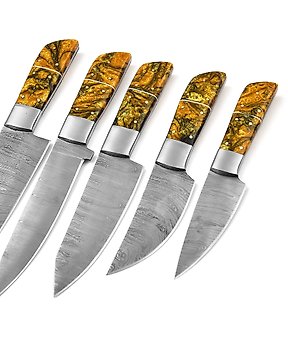
Kitchen knife - Chef's knife - Resin and damascus steel - North America
No. 83715901

No. 83715901

Condition: As new, unused
Age: 2020: Resin and Damascus steel
Origin: NORTH AMERICA
Damascus steel: used for this blade consists of layers of low carbon and high carbon mixture welded, forged and hammered several times to obtain up to 200 layers
Chef knife: is the most versatile type of kitchen knife making it a must have item in every kitchen
chopping herbs and nuts
dicing and slicing fruits, vegetables and meat
mincing and crushing garlic
cutting through melons
Butcher knife: have a long curved blade with a sharp point at the end which helps with cutting through meat cleanly and easily with sawing motion
Cutting through skin , cartilage and bones
Portioning large portions of meat, including whole carcasses racks of ribs and beef primal cuts
Trimming fat and sinew
Paring knife: are light weight and have a short blade with a pointed tip to make them useful for delicate knifework
peeling skins for garnishes
deveining shrimp
trimming excess fat off meat
Nakiri means leaf cutter in Japanese, and this is the knife's specialty, to mince, chop, dice, and slice vegetables. Its broad rectangular blade characterizes it with a flat and blunt tip which is often rounded and not pointed. Besides vegetables, a Nakiri knife is also excellent for cutting fruits
Knife maintenance: proper sharpening, cleaning and storage are all important knife safety tips
Clean your knife as soon as you are done using it to prevent cross contamination
Wash your knifes by hand rather than running them through the dishwasher
Regularly sharpen and hone your knives to keep the blade sharp
Allow knives to air dry completely before storing them
Always wash your knives when you receive the shipment because oil is used to keep them safe from rust.
We recommend a professional tune-up at least once a year, even if you are sharpening at home. If you do not sharpen your own knives, we recommend you have them sharpened when they start to feel dull. A sharp knife is always safer than a dull knife.
How to buy on Catawiki
1. Discover something special
2. Place the top bid
3. Make a secure payment